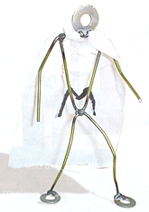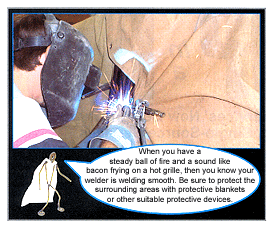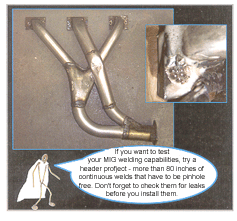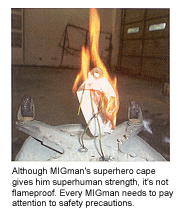
MIGman … more versatile than a Mennonite at a barn raising … able to make strong welds in a single pass … conquers sloppy welds with a minimum amount of sweat. But you don’t become a MIGman overnight. It takes determination and practice.I’m sure you all agree as I do that MIG welding articles have been done to death.
Now don’t get me wrong. I know there are plenty of reasons for this – first and foremost, because it’s important to have good, if not great, welds to ensure quality repairs. This, in turn, is necessary so that you can deliver a safe, solid repair to your customers who help to feed you and your family by returning each time they need a repair done.
You’re probably wondering, “Where is this guy headed with this line of thought?” Well, I’m going to tell you. The best way for me to learn anything is to make it fun or, at least, for me not to realize that what I’m doing is learning. And that’s what I want to do for you – make learning better MIG welding techniques fun.
Right about now you may be muttering something about how this guy (meaning me) has really lost it because you can’t make the monotonous hours required to master welding fun.
Not so. It can be fun. All we need are projects that require the use of the MIG welder.
Most of my actual training has evolved from the special projects I’ve been involved in over the years. For some reason, the techs at the dealership body shop where I work seem to be looked upon as what I would have to label “suckers.” I say this because we often get talked into doing any project that involves welding, often with no more than a “thanks” when we’re done.
Forget the fact that in the service department, they have one of the smoothest arc welders I’ve ever used just sitting there waiting for them to grab it and do these projects themselves. In fact, I’ll occasionally go to the service department to use their welder to do their project after they explain that they could does it if only they had “the equipment.”
Maybe we don’t deserve much thanks. After all, it didn’t take us long, and we must not have anything better to do, right? Well, actually it does take us a while, and maybe we do have better things to do. Or do we? My point here is that each of those special projects we get roped into doing actually does help to train us by exercising our welding talents.
Modest Beginnings

Let me go back right”for a moment to a time when I got my initiation into the welding world. I was probably about 12 years old, and I’d been at a nearby construction site with my bicycle, jumping the seemingly endless mounds of clay that they’d piled around the site.
I was a rather robust child, and my third-hand bicycle frame apparently couldn’t stand the repeated force being expelled upon it during a day of flying and landing multiple times in the rocky soil. The frame had experienced metal fatigue at the joint just in front of the rear axle, causing a break in the frame.
My stepbrother Bob got wind of my plight and took it upon himself to help me out, as he often did, by bringing me a welder. I asked him if he was going to weld my frame for me, and he said, “No son. You ain’t going to learn any younger.”
Although this wasn’t a MIG welder, it did peak my interest regarding the science of metal joining – even though my first welding experience was less than sensational.
I’d tried to butt-weld that bicycle frame with a 110-volt arc welder with no real success. That’s when Bob taught me about preparing surfaces for welding and reinforcing a weld with gussets.
After that, I was on the road again, looking to conquer any mound of dirt that “needed jumpin.”
The Days of Old
That old arc welder I used to weld up that old bicycle wasn’t a MIG, but it had more in common with it than the welders we used back in the ’70s when I first started doing body work. Our method of metal joinery involved the old oxy-acetylene torch running brass, or when we could take the heat, actually welding with mild steel rod.
This seems so crude to me now after experiencing the advantages we have with the MIG. The warpage we experienced with all that extra heat made us into metal shrinking, plastic sculpting artists. If only we would have had a MIG welder. That would’ve been like giving Davey Crocket a machine gun at the Alamo. Things could have really been different.
Different? Yes. Better? I think so, but not without paying a price. (I’m talking about the MIG here, not the machine gun.)
Because of the MIG welder, most technicians I run into today don’t really have a grasp about how to hammer weld or even “shrink” metal. All the heat that the old torch generated necessitated us to learn how to shrink and smooth badly warped metal.
The art of metal shrinking involves a series of heating, upsetting the metal, hammer and dollying the surface, and finishing it off with a quench of water to set all that metal back to a hopefully repairable surface. It was all a matter of using the heat and hammer to control the metal.
I’m not putting down modern technicians for not learning to shrink metal. It’s not their fault. The opportunities for us to shrink metal are so uncommon today because of the MIG that it’s no wonder it’s becoming a lost art.
As hard as it is for me to adopt “new and better” methods, adopting the MIG is one of the best and easiest changes I’ve ever allowed myself to adopt.
The Versatile MIG
Given the right optional equipment and setup, you can weld almost anything with a MIG welder. In my opinion, other welders can weld certain things better, but there’s no equal to the MIG that I’m aware when it comes to versatility and ease of use.
I’ve welded stainless headers on a drag boat, aluminum hardware on sailboats and even the mild steel and high strength steels that are so common on the vehicles we repair. Many of these were just projects for friends or myself, but the experience of each has increased my understanding of the MIG, along with increasing my skill level.
STRSW is great in its place and heli-arc welding shines well in aluminum applications, but the MIG can be substituted for either in any of the situations I’ve ever run into in the collision repair industry.
Most bodymen are far from welding experts, but as easy as the MIG is to get used to, even a man with my limited mental capacity can learn the mechanics of using a MIG in a short time. Notice I said “learn the mechanics” in a short time. That’s because there’s more to MIG welding than just the mechanics, and as with any acquired skill, practice is required.
Mower Mayhem

If you’re familiar with the semi-rough terrain here in the Ozarks, then you know we have added opportunities for projects when the grass kicks into high gear in the spring. Being a typical male, I tend to put off cutting the grass until it has snuck its way past the “needing mowed soon” stage all the way to the “How will I ever cut my way through that without a machete?” stage.
Also, because I’m a typical male, I – like many other men – sometimes store car parts in strategically placed and obvious locations around my yard.
Obvious, that is, until the Missouri grass grows up to camouflage these chunks of steel treasures, turning them into hidden objects of destruction akin to an M18 claymore in a warfield. The old saying, “You might be a redneck if you mow your yard and find a car” is more of a reality than a joke here.
And when you find that car part, it can wreak havoc on a mower and anything it comes in contact with once the mower pitches it through the air.
Come Monday morning, there’s often a couple of people or more who rope us into a welding project. Although these projects don’t always appear to have any obvious learning value, if we’re squeezing the trigger and making sparks fly, there’s potential to learn something about the capabilities of the MIG.
I’ve used my MIG welder to repair torn keyways in crankshafts and to weld torn mower decks from paper-thin light gauge sheetmetal all the way up to the 3/16-inch deck on my own mower. And the MIG is flexible enough to weld the whole gamut of materials. I’ve even had requests to “just weld the danged old pulley to the shaft, cause that’s all this mower is worth anyhow!”
Now if one would just jump in and weld that “danged” pulley to the shaft without much thought (which I did), he might get a lesson in welding dissimilar metals (which I did), such as seeing that pulley fly off (which it did), coming at you like Obbjob’s hat in a James Bond movie.

We also occasionally run into dissimilar metals in the collision repair business that shouldn’t be welded together, and this is a good illustration of why. On those occasions when we have dissimilar metals, the part is typically bolted or riveted on.
I know mowers are a far cry from automobiles, but these repair projects can instill some knowledge that can be helpful when repairing collision damage.
Special Projects = MIG Practice
The list of special projects needing to be done that involve the MIG seems to be never ending. Let me give you a short list of some of the projects I’ve involved myself in and what I’ve learned from them:
-
- Project: I was volunteered to make a radiator repair stand and holding tank years ago for the dealership. (And the old radiator test tank held water long enough for the evolution of the radiator to make that type of repair infrequent enough to do away with the still-working tank.)
What I learned: Although, in theory, it was simple to build and weld a holding tank and rack such as this, it actually involved many feet of continuous welds, which in itself was great practice (similar to welding a large frame section together). In the end, it also turned out to be a great test (will your welds hold water?), a porosity test in effect without cutting the weld in half. The welds we typically do during collision repair rarely get tested for porosity like these welds did, but if you think about it, welds that wouldn’t hold water aren’t as strong as they could be because of porosity. How strong do you want the welds to be that you sell to your customer?
-
- Project: I made a set of exhaust headers to fit an old British car that I like to play with.
What I learned: Projects like this one are quite a test of welding skill, since even the tiniest of pinholes can cause an exhaust or gas leak. After welding the headers, plates were made to seal and pressurize them to check for flaws. I have to admit, there were some pinholes that these tired, old eyes couldn’t see, and that opened my eyes to checking all my welds more thoroughly.
An example of heat distortion also reared its ugly head when I tried to bolt the header back onto the head – after neglecting to securely bolt it down while welding up a section between tack welds. Sounds like the same results you get when welding a sail panel without adequate clamping. Heat seems to have an awesome force if allowed to go unrestrained.
- Project: I made a set of exhaust headers to fit an old British car that I like to play with.
-
- Project: One project involved cutting a corner out of a gas tank to clear larger tires on a V8 conversion on an old Vega. (End result: All was well, and the gas-tank held fuel fine.)
What I learned: During this exercise, I kept reliving in my head the story of a technician from a neighboring state (Arkansas) who came to work at our dealership years ago. We had a gas tank that needed a minor solder repair to stop a leak, and the new-to-us tech said we were wasting precious time by having the tank steamed out to remove all traces of fumes. Well, the story goes as follows …
The technician climbed on top of said tank with the torch and solder to proceed with the repair. Shortly thereafter, a loud boom was emitted from the area. The sight of “flying technician man” brought a series of laughter throughout the shop until the whole “gravity” of the situation and dangers therein became apparent as the technician came crashing to the ground. (Don’t worry. He was OK. The major trauma was only to his head so really nothing to hurt there. Seriously, he was fine. In fact, they tell me he was laughing at himself as he hit the floor.)
Keep “flying technician man” in mind when you’re repairing vehicles. We have many potential hazards – such as exploding fumes from such tanks, spark damage to glass and even voltage spikes to electrical components – that we need to guard from. Follow the manufacturer’s warnings, and you should have no worries. (You did know that service manuals warn you of such hazards, didn’t you?)
- Project: One project involved cutting a corner out of a gas tank to clear larger tires on a V8 conversion on an old Vega. (End result: All was well, and the gas-tank held fuel fine.)
- Project: I welded razor blades edge to edge for a friend to display with his MIG welders that he sold in his store. (As far as the razor blades go though, I’m afraid they’ll never shave again.
What I learned: This project proved to be quite a challenge trying not to blow holes in the paper-thin metal. Have you ever blown a hole in a car body unintentionally? This was great practice for learning how to keep from doing just that. If you can learn to weld thinner metals in practice, it makes it so much easier when you move up to the thicker materials that we commonly work on in collision repair.
Just Say No
Occasionally, I’ve been asked to do the impossible. In cases such as this, I have to remember to just say no!
I had an occasion such as this when a mechanic from our service department asked me if I could weld a hardened piece of metal to the top of a valve stem on a valve that was still installed in the engine of an Astro van. He seemed sincere with his request as he explained that the customer needed his vehicle (which was still covered under warranty) for the next day of work.
I dug deep inside my thoughts before I told him to be a hero and fix it right the first time. As tempting as any challenge is to the typical male, one should learn to choose his battles.
It doesn’t hurt to try something you don’t think will work if there’s nothing to lose. It can be a valuable learning experience. But if you’re risking your reputation or, worse yet, compromising safety, just say no.
Practice, Practice, Practice!
Looking back, maybe I should have attempted to weld that valve stem. After all, bamboo shoots are getting harder to find to shove under my fingernails, and I haven’t set myself on fire in a good while so that could have proven to be quite fun.
NOT!
In reality, I do like to try the seemingly impossible occasionally, if only to bring me back down to earth and to give me back the perspective I seem to lose so easily. It’s true that if you only try what others have shown you will work, you’ll probably never fail. On the other hand, if you use your imagination, you might find that many things that have never been attempted before are possible.
When I talk about trying unusual things, however, my intentions are not for you to “try” unproven techniques when repairing vehicles. These special projects I’ve mentioned are for practice only – to enhance my capabilities with the MIG.
Most all of us have worked next to someone who didn’t seem to have a clue about welding. Most likely, that’s because he only welds when he needs to.
They always refer to doctors as “practicing.” Well, we’re practicing too. Fact is, if you really want to become a MIGman, you can’t ever quit practicing.
Contributing editor Keith Combs is the body shop manager at Bill Roberts Chevrolet, where he’s been employed for 25 years. He was named GM/ASE Master Collision Repair/Refinish Technician of the Year 2000 and was one of the first to achieve GM’s World Class Technician status in 2002.













